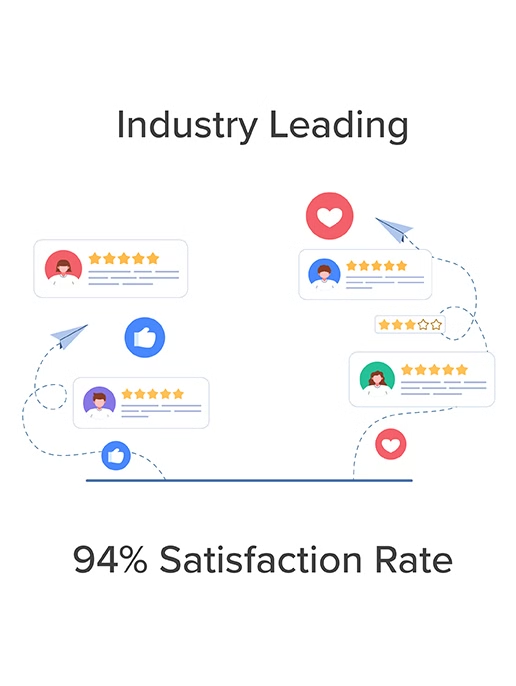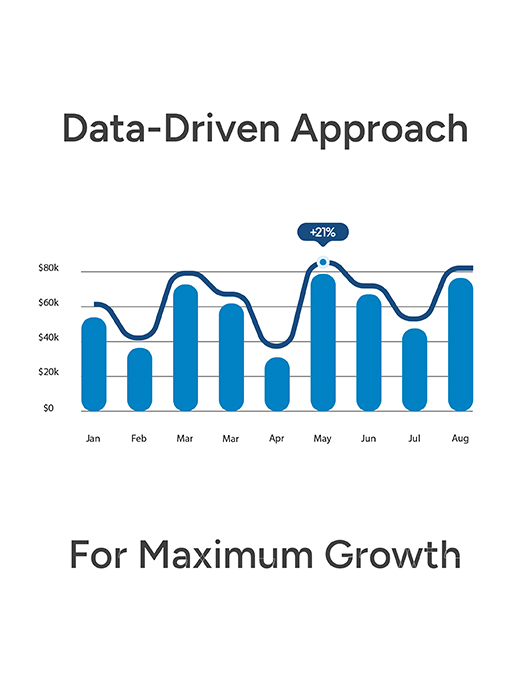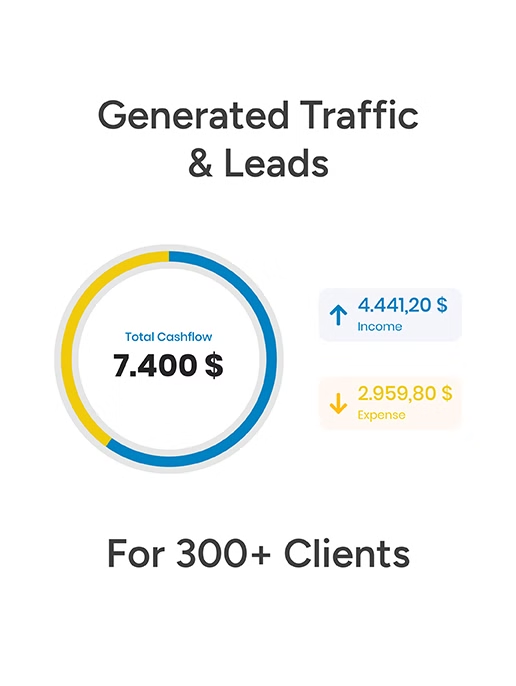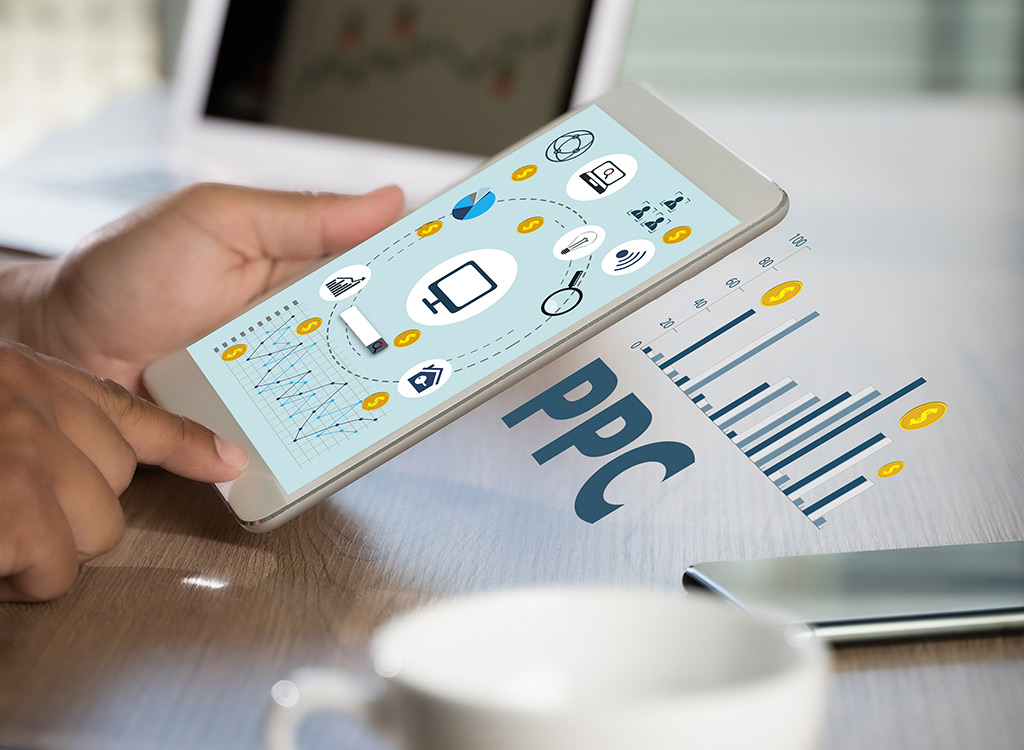


Establish a solid online presence for your business with a fully responsive website. Our creative approach and technical expertise ensure an engaging website that drives conversions.
Responsiveness and user experience on a website are direct ranking factors. With our responsive web design services, get increased visibility and organic traffic from search engines for your business.

Reach ideal businesses with data-driven B2B PPC campaigns. We create PPC campaigns focusing specifically on industries, job titles, and companies. Our customized approach is designed to bring more relevant visitors to your site and turn visitors into leads.
Our team of experienced professionals relies on extensive data analysis to refine your campaigns to ensure your ads reach the ideal businesses. From the initial awareness to the final decision, our B2B PPC campaigns meet your audience’s specific concerns and needs at every step of their buying process.
Let our certified PPC management experts help you create advertising success stories. At Redefine Web, we optimize your campaigns to ensure the best ROI for your business. We fine-tune your campaigns following launch to ensure your campaigns continue to perform at their best.
We use innovative tools and strategies to ensure your campaigns reach the ideal customers. Work with one of the best B2B PPC management companies to increase leads and conversions, making your advertising spend an intelligent investment for your company’s future.

We often send out our newsletter with news and great offers. We will never disclose your data to third parties and you can unsubscribe from the newsletter at any time.
Unfortunately, we’re unable to offer free samples. As a retailer, we buy all magazines from their publishers at the regular trade price. However, you could contact the magazine’s publisher directly to ask if they can send you a free copy.
You can create a new account at the end of the order process or on the following page. You can view all of your orders and subscriptions in your customer account. You can also change your addresses and your password.
No, you don’t have to create an account. But there are a few advantages if you create an account.
You never have to enter your billing and shipping address again
Find all of your orders, subscriptions and addresses in your account
Download invoices of your orders
No, we don’t have a physical store location at the moment. We accept only orders through our online shop and we’re shipping all orders with the Swiss Post Service. Please visit our shipping section for more details.
From time to time you will find us at design fairs and popup markets in Switzerland. Subscribe to our newsletter and you’ll receive the latest news.
Businesses selling to other companies (B2B) approach things differently than those selling directly to consumers (B2C). B2B PPC ads grab the attention of people who purchase on their companies’ behalf. These buyers usually seek products or services to improve their business operations or profitability. As a result, B2B advertising is more information-driven. The ads often focus on the return on investment (ROI) and the long-term benefits of the product or service. They also consider that business purchases usually take longer and involve more people.
In contrast, B2C PPC ads target individual consumers. These ads aim to tap into personal desires, convenience, and immediate needs. They’re often more emotional and strive to get a quick response. For example, a B2C ad might highlight a sale ending soon to create a sense of urgency, while a B2B ad might offer a whitepaper that helps a business solve a problem.
To make sure B2B PPC campaigns reach the right business audiences, we get specific with our strategies.
First, when searching for solutions, we begin by researching and using keywords that business professionals will likely use. We also create detailed profiles of our ideal business customers, considering what challenges they face and what they need most. We make our ad messages more technical and focus on benefits and features that matter to a business audience.
We also design landing pages that serve as a resource for these professional visitors. These pages might offer something valuable, such as a free trial, a demo, or a downloadable guide, which can help potential customers learn more about how a product or service can help their business. This approach helps to build a relationship with potential clients and guide them through the decision-making process, which is often more complex and takes longer in the B2B world.
Google Ads: We are well-versed in Google Ads and are known for their broad reach. This platform lets us showcase your business across various websites and Google search results, ensuring your ads appear where potential clients are looking.
LinkedIn Ads: LinkedIn Ads is our go-to platform for targeting professionals and specific industries. It’s excellent for reaching decision-makers and industry influencers, helping you connect with the right people in a business setting.
Microsoft Advertising: We also work with Microsoft Advertising. This platform can help you tap into unique markets and reach audiences that competitors might not as heavily target.
Each platform has its strengths, which we use to tailor campaigns that align with your marketing goals.
Our strategy for keyword research for B2B PPC is thorough and focused. We start by identifying keywords closely related to your business solutions and the specific needs of your potential clients. This often involves looking for longer, more particular phrases known as long-tail keywords. These keywords usually signal a solid intent to engage or buy.
Understanding the keywords they target allows us to find opportunities for your campaigns. Plus, if your audience uses that, we’re not afraid to get technical with industry jargon. We aim to ensure our selected keywords attract your business’s most relevant and qualified leads.
We’re here to help you launch and look after B2B PPC campaigns on various platforms. This means we’ll create a unified strategy designed to spread the word about your business and get more people interested in what you’re selling. Our team knows how to tweak these campaigns to work well with each platform’s unique features and how their users behave. This knowledge lets us give our clients a smooth and practical advertising experience.
We use detailed targeting tools to ensure we’re talking to the right people in a business. This includes job titles, the type of industry, the size of the company, and even specific LinkedIn groups. We also look at where these users are in the buying process and change our ads to give them the info they need at that moment. This approach helps us catch the attention of the folks who have the power to decide if they want to buy what you’re offering.
Audience targeting and segmentation for B2B pay-per-click (PPC) campaigns are all about understanding your ideal customers and how best to reach them. We start by researching the market to gather as much information as possible about your potential buyers. From there, we create detailed buyer personas—these are like snapshots of your ideal customers, including their job roles, industries, and what challenges they face that your product or service can solve.
Once we have these personas, we break down the audience even further. We look at specific industries that are most likely to need what you’re offering. Then, we consider the job functions within those industries, such as decision-makers or influencers, and even their level of seniority. This way, we can tailor your PPC ads to speak directly to their pain points and interests. The result? More personalized ads are more likely to grab attention, engage your potential customers, and encourage them to take action, such as filling out a contact form or making a purchase.
To measure the success of B2B PPC campaigns, we focus on several key performance indicators (KPIs). The click-through rate (CTR) tells how often people who see your ad click. It’s a good measure of how relevant and appealing your ad is to your target audience. The conversion rate is another crucial metric—it shows us the percentage of people who click on your ad and then take a desired action, like signing up for more information or purchasing.
We also closely monitor the cost per acquisition (CPA), which helps us understand how much you spend to gain a new customer. Return on ad spend (ROAS) is all about the return you get from your investment in PPC ads. And finally, we look at lead quality, which assesses how likely the leads generated from your ads are to become paying customers. By monitoring these metrics, we can see what’s working and what’s not and then make informed decisions to tweak and improve your campaigns for better results and a more substantial return on investment.
Yes! We create our ad creative design services with the needs of B2B audiences in mind. We focus on developing professional and visually appealing designs that resonate with businesses’ interests and needs. Our close collaboration with clients ensures that the designs accurately represent their brand identity and effectively communicate their unique selling points. We aim to create ad creatives that capture attention, engage business decision-makers, and drive higher conversion rates.
A/B testing is a vital part of our approach to optimizing B2B PPC campaigns. We test different aspects of the campaigns, including ad copy variations, landing page designs, and other calls to action, to see which versions perform the best. By comparing the results, we can identify the most effective elements that appeal to the target audience. This ongoing process of experimentation and change helps us continuously enhance our campaigns’ performance, ensuring that our clients get the best return on their investment. We believe in making data-driven decisions to fine-tune our strategies and achieve better results.
Competitor analysis in B2B PPC campaigns involves a deep dive into what your competitors are doing with their ads. We closely monitor the types of ads they’re running, the keywords they’re targeting, and where they’re positioning themselves in the ad space. By understanding their strategies, we can see what’s working for them and what isn’t. With this knowledge, we compare their tactics to the standards in the industry and see how our clients stack up. This isn’t just about keeping up with the competition; it’s about finding those gaps and opportunities where our clients can stand out. By doing this, we help our clients carve out their own space in the market and gain a competitive edge with their B2B PPC campaigns.
Monitoring B2B PPC campaigns is all about staying on top of the data. We regularly review your PPC campaign data to see what it tells us. This might involve looking at how different keywords perform, which ads get the most clicks, and which campaigns lead to sales. If we see something that’s not working as well as it could be, we’re quick to make changes. This could mean changing how much we bid on specific keywords, tweaking who we’re targeting, or revamping our ad designs. The key is refining our approach based on what the data shows us. By constantly adjusting and improving, we ensure our clients’ campaigns are as effective as possible, getting them the best return on their investment.
Certainly! We ensure you’re always in the loop with how your B2B PPC campaigns perform. Our reports are detailed and easy to understand, featuring essential metrics such as click-through rates, conversion rates, and cost per acquisition. We also provide insights to help you understand the data and strategic recommendations for moving forward. Expect to receive updates that will give you a clear picture of your progress and offer valuable information to guide your PPC strategy decisions.
Absolutely! We’re well-versed in creating and managing B2B PPC campaigns tailored to specific industries. Our approach involves understanding your business’s unique needs and objectives. We then design strategies specific to your industry and align them with your goals. This means we’ll help you reach the right audience effectively, whether you’re in technology, healthcare, manufacturing, or any other sector.
Yes, transparency is a cornerstone of our service. We make sure you always know how your budget is being used. You’ll have full access to your PPC account and receive clear, regular reports. This way, you can see the impact of your ad spend and understand the value you’re getting from our management services. We want you to feel confident in the investment you’re making in your PPC campaigns.
We work with you to understand your goals and ensure your B2B pay-per-click (PPC) campaigns work well with your marketing plan. We start by learning your business goals and who you want to reach. Then, we look at what you’re already doing to market your business. This information allows us to make PPC campaigns that fit your marketing mix. This way, your PPC efforts will help you grow your business and strengthen your brand.
